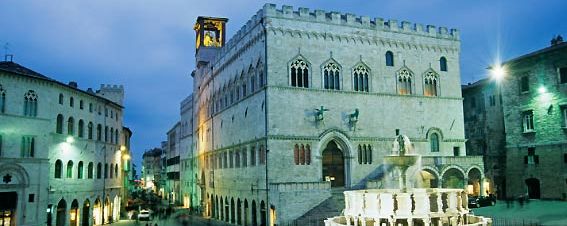
Assisi
 Assisi (Latin: Asisium), is a town in Italy in province of Perugia, Italy, in the Umbria region,
on the western flank of Monte Subasio.
Assisi (Latin: Asisium), is a town in Italy in province of Perugia, Italy, in the Umbria region,
on the western flank of Monte Subasio.It is the birthplace of St. Francis, who founded the Franciscan religious order in the town in 1208, and St. Clare (Chiara d'Offreducci), the founder of the Poor Clares. Saint Gabriel of Our Lady of Sorrows of the 19th century was also born in Assisi.
How to reach Assisi
By car
From the north (Milan, Florence), the best exit for Assisi on the A1 motorway at Valdichiana, where the superstrada SS75bis branches into Umbria at Lake Trasimene and continues towards Perugia-Assisi. From Rome travelling northwards along the A1 motorway the best exit for reaching Assisi is at Orte, which is connected to the regional capital at first by the ss204 to Terni and then by the E45 (or SS3bis) from Terni to Perugia-Assisi.
The A14 motorway down the Adriatic coast of Italy has an exit at Cesena for the E45 "superstrada" to Città di Castello and Perugia-Assisi.

By train
From the North, the main line between Florence and Rome has a station at Terontola (on the branch line to Lake Trasimene, Perugia, Assisi, Spello, and Foligno), so coming from Florence take one of the dozen daily trains to Terontola/Cortona (1'/2 hr.) that meet up with a connecting train to Assisi/S.Maria degli ANgeli (45 to 60 min.).
From the South, the main line between Rome and Ancona has a station at Foligno (on the branch line to Spello, Assisi, Perugia and Lake Trasimene), so coming from Rome, take one of the nine daily trains on the line to Ancona, stop at Foligno (1 hr., 40 min. to 2 hr.), where you can transfer to a Perugia-bound train (10 to 15 min.).
All the cited lines are part of the FS state-run railway system and stop at a station on Santa MAria degli Angeli, well away from the historic center (about 3km) but a 30-minute ride on buses from the center of town (C Line). Bus services leave from the forecourt outside the station and drop you in Piazza Matteotti.
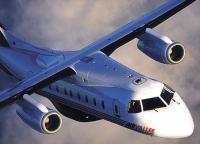
By air
Perugia's tiny Aeroporto Sant'Egidio (PEG) (PHONE: 075/592141) has only daily flights to and from Milan, where direct flights are
available from and to most of the main international destinations. It is located 11km from Assisi.
Unfortunately from the Airport to Assisi (and vice-versa) there isn't any bus (but some Assisi hotel have a pick-up service),
best way to get to Airport is by Taxi or renting a car.
Parking at the airport is free of charge. All the chief national and international car rental companies have offices at the airport.
The airport is reachable by bus from Perugia, the bus stop in Piazza Italia and in the main railway station of Perugia.
HOW TO REACH THE AIRPORT FROM PERUGIA
Bus Timetable from Perugia:
Departure Piazza Italia: 6.15am-12.50pm-4.50pm
Departure Railway F.S. Station: 6.30am-1.00pm-5.05pm
Arrival Airport: 7.00am-13.30pm-5.25pm
Bus Timetable from the Airport:
Departure: 2.40pm-5.50pm-9.50pm
Arrival Perugia Railway F.S. Station: 3.10pm-6.20pm-10.15pm
Arrival Perugia Piazza Italia: 3.15pm-6.30pm-10.25pm
Bus Fare € 2.58
INFORMATION
Reservation Toll Free Numbers:
8488-65641 (Domestic Flights)
8488-65642 (International flights)
8488-65643 (Information)
Flights Timetable:
Domestic Flight Perugia - Milan (Malpensa)
Domestic Flights Milan (Malpensa) - Perugia
International Flights to Denmark
History
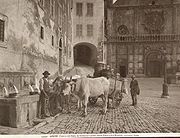 Around 1000 BC a wave of immigrants settled in the upper Tiber valley as far as the Adriatic Sea
and also in the neighbourhood of Assisi. These were the Umbrians, living in small fortified settlements
on high ground.
Around 1000 BC a wave of immigrants settled in the upper Tiber valley as far as the Adriatic Sea
and also in the neighbourhood of Assisi. These were the Umbrians, living in small fortified settlements
on high ground.
From 450 BC these settlements were gradually taken over by the Etruscans.
The Romans took control of central Italy by the Battle of Sentinum in 295 BC. They built the
flourishing municipium Asisium on a series of terraces on Monte Subasio.
Roman remains can
still be found in Assisi : city walls, the forum (now Piazza del Comune), a theatre, an amphitheatre
and the Temple of Minerva (now transformed into the Church of Santa Maria sopra Minerva).
In 238 AD Assisi was converted to Christianity by bishop Rufino, who was martyred at Costano. According to
tradition, his remains rest in the Cathedral Church of San Rufino in Assisi.
The Ostrogoths of king Totila destroyed most of the town in 545. Assisi then came under the rule of the
Lombards as part of the Lombard and then Frankish Duchy of Spoleto.
The thriving commune became an independent Ghibelline commune in the 11th century. Constantly struggling
with the Guelph Perugia, it was during one of those battles, the battle at Ponte San Giovanni,
that Francesco di Bernardone, (Saint Francis of Assisi), was taken prisoner, setting in motion
the events that eventually led him to live as a beggar, renounce the world and establish the
Order of Friars Minor.
 The city, which had remained within the confines of the Roman walls, began to expand outside these
walls in the 13th century. In this period the city was under papal jurisdiction. The Rocca Maggiore, the imperial
fortress on top of the hill above the city, which had been plundered by the people in 1189, was rebuilt in 1367
on orders of the papal legate, cardinal Gil de Albornoz.
The city, which had remained within the confines of the Roman walls, began to expand outside these
walls in the 13th century. In this period the city was under papal jurisdiction. The Rocca Maggiore, the imperial
fortress on top of the hill above the city, which had been plundered by the people in 1189, was rebuilt in 1367
on orders of the papal legate, cardinal Gil de Albornoz.
In the beginning Assisi fell under the rule of Perugia and later under several despots, such as
the soldier of fortune Biordo Michelotti, Gian Galeazzo Visconti and his successor Francesco I Sforza,
dukes of Milan, Jacopo Piccinino and Federico II da Montefeltro, lord of Urbino. The city went into
a deep decline through the plague of the Black Death in 1348.
The city came again under papal jurisdiction under the rule of Pope Pius II (1458-1464).
In 1569 construction was started of the Basilica of Santa Maria degli Angeli. During the Renaissance
and in later centuries, the city continued to develop peacefully, as the 17th-century palazzi of the
Bernabei and Giacobetti attest.
Now the site of many a pilgrimages, Assisi is linked in legend with its native son, St. Francis.
The gentle saint founded the Franciscan order and shares honors with St. Catherine of Siena as
the patron saint of Italy. He is remembered by many, even non-Christians, as a lover of nature
(his preaching to an audience of birds is one of the legends of his life).
Assisi was hit by the devastating twin earthquakes that shook Umbria in 1997, but the recovery and
restoration have been remarkable, although much remains to be done. Massive damage was caused to
many historical sites, but the major attraction, the Basilica di San Francesco, reopened less than two years later.
Main sights
Churches
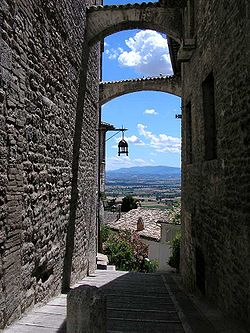 - The Basilica of San Francesco d'Assisi (St. Francis) is a World Heritage Site. The Franciscan monastery,
il Sacro Convento, and the lower and upper church (Basilica inferiore e superiore) of St Francis were begun
immediately after his canonization in 1228, and completed in 1253. The lower church has frescos by renowned
late-medieval artists Cimabue and Giotto; in the upper church are frescos of scenes in the life of St. Francis
previously ascribed to Giotto and now thought to be by artists of the circle of Pietro Cavallini of Rome.
The Basilica was badly damaged by the earthquake of September 26, 1997, when part of the vault collapsed,
killing four people inside the church and carrying with it a fresco by Cimabue. The edifice and was closed
for two years for restoration.
- The Basilica of San Francesco d'Assisi (St. Francis) is a World Heritage Site. The Franciscan monastery,
il Sacro Convento, and the lower and upper church (Basilica inferiore e superiore) of St Francis were begun
immediately after his canonization in 1228, and completed in 1253. The lower church has frescos by renowned
late-medieval artists Cimabue and Giotto; in the upper church are frescos of scenes in the life of St. Francis
previously ascribed to Giotto and now thought to be by artists of the circle of Pietro Cavallini of Rome.
The Basilica was badly damaged by the earthquake of September 26, 1997, when part of the vault collapsed,
killing four people inside the church and carrying with it a fresco by Cimabue. The edifice and was closed
for two years for restoration.
- Santa Maria Maggiore (St. Mary the Greater), the earliest extant church in Assisi.
- The Cathedral of San Rufino (St. Rufinus), with a Romanesque façade with three rose windows and a 16th-century
interior; part of it is built on a Roman cistern.
- Basilica of Santa Chiara (St Clare) with its massive lateral buttresses, rose window, and simple Gothic interior,
begun in 1257, contains the tomb of the saint and 13th-century frescoes and paintings.
- Basilica of Santa Maria degli Angeli (St. Mary of the Angels), which houses the Porziuncola.
- Chiesa Nuova, built over the presumed parental home of St. Francis
Other landmarks
The town is dominated by two medieval castles. The larger, called Rocca Maggiore, is a massive presence
meant to intimidate the people of the town: it was built by Cardinal Albornoz (1367) and added to by
Popes Pius II and Paul III. The smaller of the two was built much earlier, in the Roman era. However,
not all of it stands, and only a small portion and three towers are open to the public.
UNESCO collectively designated the major monuments and urban fabric of Assisi as a World Heritage Site.
Art
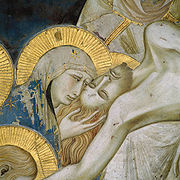 Assisi has had a rich tradition of art through the centuries and is now home to a number of
well known artistic works.
Artists Pietro Lorenzetti and Simone Martini worked shoulder to shoulder at Assisi. The Basilica of
San Francesco d'Assisi includes a number of artistic works. Simone Martini's 1317 fresco there reflects
the influence of Giotto in realism and the use of brilliant colors. Lorenzetti's fresco at the lower
church of the Basilica includes a series of panels depicting the Crucifixion of Jesus, Deposition from
the Cross, and Entombment of Christ.
Assisi has had a rich tradition of art through the centuries and is now home to a number of
well known artistic works.
Artists Pietro Lorenzetti and Simone Martini worked shoulder to shoulder at Assisi. The Basilica of
San Francesco d'Assisi includes a number of artistic works. Simone Martini's 1317 fresco there reflects
the influence of Giotto in realism and the use of brilliant colors. Lorenzetti's fresco at the lower
church of the Basilica includes a series of panels depicting the Crucifixion of Jesus, Deposition from
the Cross, and Entombment of Christ.
The figures Lorenzetti painted display emotions, yet the figures
in these scenes are governed by geometric emotional interactions, unlike many prior depictions which
appeared to be independent iconic aggregations. Lorenzetti's 1330 Madonna dei Tramonti also reflects
the ongoing influence of Giotto on his Marian art, midway through his career
Culture
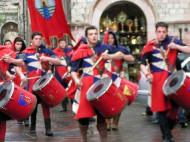 Festival Calendimaggio, held on May 1-5, is a re-enactment of medieval and Renaissance life in the
form of a challenge between the upper faction and the lower faction of the town. It includes processions,
theatrical presentations, flag-weavers and dances.
Festival Calendimaggio, held on May 1-5, is a re-enactment of medieval and Renaissance life in the
form of a challenge between the upper faction and the lower faction of the town. It includes processions,
theatrical presentations, flag-weavers and dances.
Assisi Embroidery is a form of counted-thread embroidery which has been practised in Assisi since the 13th century.
Today the town has many groups coming to enjoy the simple peace of St. Francis. One such group has restored
an 11th century room and added altars to the world's religions.
